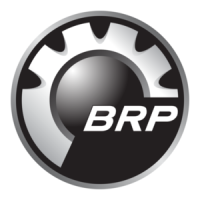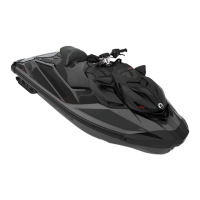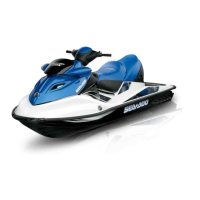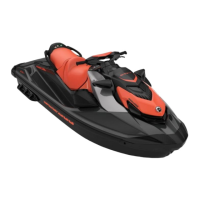
Do you have a question about the BRP Sea-Doo GTX 170 2022 and is the answer not in the manual?
Ensure the operator is 16 or older and has taken a boater safety course.
Scan constantly for people, objects, and other watercraft. Stay far enough away.
All riders must wear an approved PFD and neoprene shorts. Be sure riders are properly seated.
Avoid spraying others, going too close to boats, or going too fast. Never ride after consuming alcohol or drugs.
Covers operator qualifications, age, ability, drugs, alcohol, and safe boating courses.
Understanding the PWC's performance, controls, and handling characteristics.
Covers safe riding practices with passengers and avoiding collisions.
Describes exercises like turning, stopping distances, obstacle avoidance, and docking.
A checklist of items to inspect on the watercraft before launching into water.
Checks to perform on the watercraft after launching and before riding.
Identifies and explains the function of various controls on the watercraft.
Describes the various components and features of the watercraft.
Details how the iBR lever controls braking, reverse, and neutral functions.
Details warning and telltale lights and their meanings for the LCD display.
Details how to set up the ski mode with ramp and target speed.
Explains the required break-in period and throttle usage for optimal performance.
Provides methods for safely boarding the watercraft from a dock or shallow water.
Step-by-step instructions for starting the watercraft engine safely.
Explains how to safely shut down the watercraft engine.
Details how to control the watercraft's direction using the handlebar and throttle.
Explains how to engage neutral and adjust the neutral position.
Instructions on engaging forward thrust from neutral or reverse.
Details how to engage and use the reverse thrust function.
Explains how to engage and use the iBR braking system.
Instructions on adjusting the VTS for optimal performance and handling.
Provides general advice for safe operation, including crossing wakes and docking.
Guides on using the iDF system to remove debris from the jet pump.
Provides instant throttle response and rapid acceleration for performance.
Enables setting speed limiters and slow speed modes for controlled operation.
Allows setting a desired maximum watercraft speed for controlled cruising.
Instructions for basic maintenance tasks like oil changes and spark plug replacement.
Provides guidance for diagnosing and resolving common engine and system issues.
Explains how the system monitors components and alerts the operator to faults.
Lists potential causes and solutions when the engine fails to start.
Addresses issues with slow engine cranking, possibly due to battery or starter problems.
Troubleshooting steps when the engine cranks but does not start.
Diagnoses causes and solutions for engine misfires or irregular running.
Identifies causes of engine smoke, such as high oil level or water ingestion.
Troubleshooting steps for engine overheating issues.
Addresses causes for lack of acceleration or power, including mode settings and fuel issues.
Troubleshooting for issues preventing the watercraft from reaching top speed.
Details the limited warranty terms for USA and Canada.
Covers the warranty for engine emission control systems under EPA regulations.
Explains the evaporative emissions control system warranty for California.
Details emission control warranty for California and New York.
Details the limited warranty terms for European Economic Area, CIS, and Turkey.












